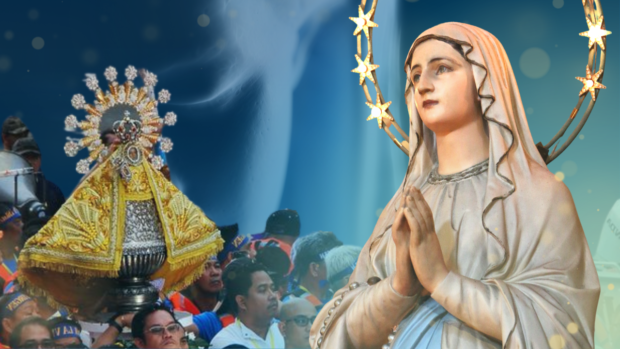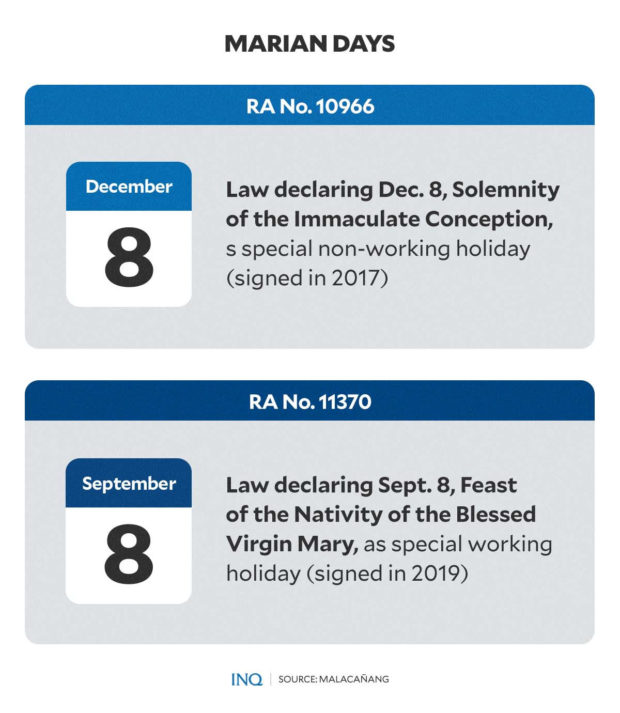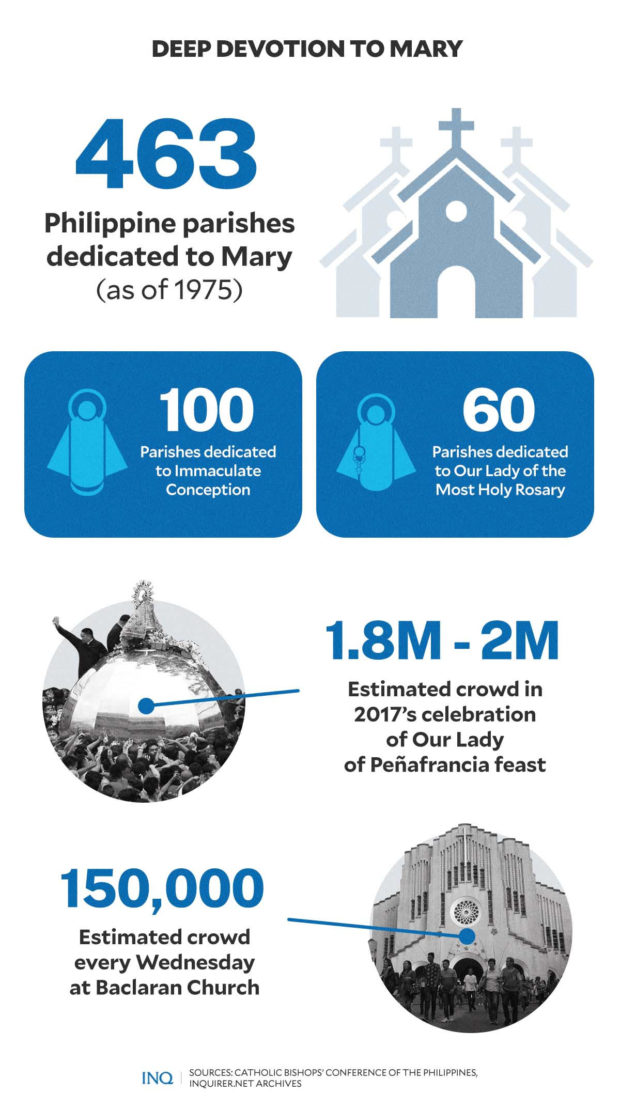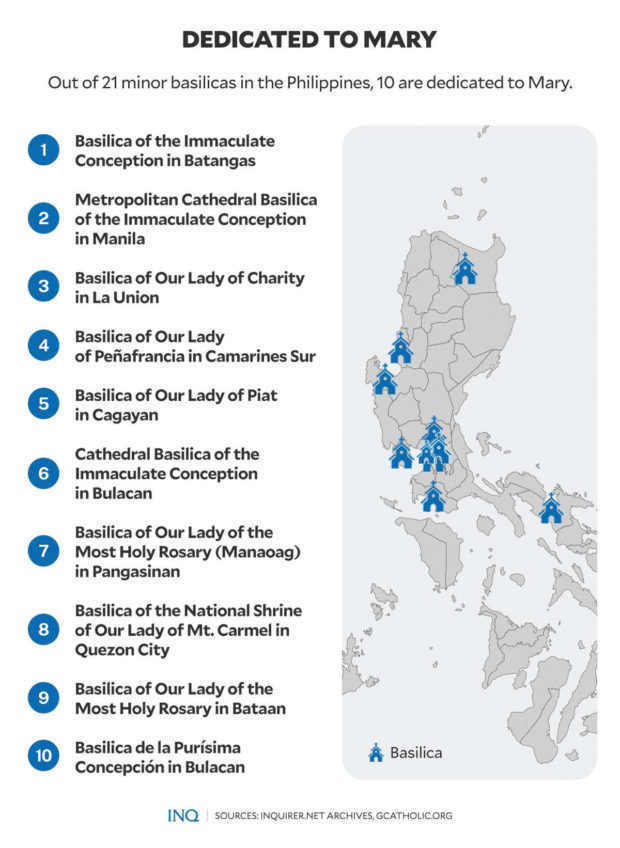‘People in love’: Understanding Filipinos’ deep, strong faith in Mary
MANILA, Philippines—“Pueblo amante de Maria (People in love with Mary).”
Theologian Fr. Catalino Arevalo, SJ said this was how Filipinos were described in the song for the International Eucharistic Congress, which was held in Manila on Feb. 3 to 7, 1937.
READ: ‘Pueblo amante de Maria’
Arevalo stressed in the book “Pueblo Amante de Maria: The Filipinos’ Love for Mary” that the Filipinos’ devotion to Mary is one of the key dimensions of the presence of Catholicism in the Philippines.
Last May 31, Archbishop Charles Brown, the apostolic nuncio to the Philippines, recognized Filipinos’ strong piety to Mary, saying that “let us love her because […] she is the one who constantly intercedes for us before Jesus”.
Fr. Dennis Lauron, parochial vicar of the Our Lady of Atocha Parish in Isabela province, told INQUIRER.net that Filipinos were described as “people in love with Mary” because of “our strong family ties that makes us love and embrace Mary as mother”.
The Archdiocese of Manila said the Philippines has always been well known for its love for Mary, stressing that since “we call our mothers when we are in need, we have forged a strong relationship with the Blessed Mother”.
This was the reason that Marian celebrations in the Philippines, like the Feast of the Nativity of Mary, always draw thousands to millions of people taking part in Masses and processions.
Mary’s birth
The Franciscan Media said the Church has celebrated Mary’s birth since the sixth century, explaining that Sept. 8 was chosen because the Eastern Church begins its year with September.
In 2019, then President Rodrigo Duterte declared Sept. 8 as a “national special working holiday,” saying that Mary is “the epitome of faith and source of inspiration” for many Filipinos.
READ: New law declares Sept. 8 a special working holiday
It was explained by the Franciscan Media that the date helped in determining the date for the Solemnity of the Immaculate Conception, Dec. 8, which was a “special non-working holiday” in the Philippines.
READ: Dec. 8, Feast of Immaculate Conception, is special non-working holiday
“Scripture does not give an account of Mary’s birth. However, the apocryphal ‘Protoevangelium of James’ fills in the gap. This work has no historical value, but it does reflect the development of Christian piety,” it said.
This stated that Anna and Joachim, Mary’s parents, were infertile but prayed for a child. They received the promise of a child who will advance God’s plan of salvation for the world. This, the Franciscan Media said, stresses the special presence of God in Mary’s life.
Fr. Francis Ongkingco said in a Cebu Daily News column that usually, the Church celebrates only the dies natalis—birth into heaven—to remember a saint’s death or martyrdom, but there’s an exception when it comes to Mary and St. John the Baptist.
He said this was because the birth of the two “are so intimately associated with Jesus’ birth,” explaining that St. John the Baptist was born to announce the coming of Jesus, while Mary was born to bear God in her womb and give birth to him.
RELATED STORY: Weekends with Mary: Man’s devotion takes him around PH
Strong devotion
The late cardinal, Cebu Archbishop Julio Rosales, said “Filipinos are indeed a religious people” and that the thousands of churches and chapels all over the islands, from Batanes to Jolo, reflect how Christianity has become an integral part of Filipino life.
He said, “when one tries to determine the characteristic[s] of our Christian faith, one finds that our practice of religion has taken on a popular color and has a special sense of devotion that makes it specifically Filipino.”
He stressed that there’s a “special place the Mother of Christ has in the life of the Filipino people,” saying that the “endless symphony of Marian names in the baptismal records of our parishes constitutes a tribute to the devotion of our people to Mary”.
Rosales, who served as president of the Catholic Bishops’ Conference of the Philippines, said the “knowledge of the sincere veneration of our people for Mary has given us particular comfort and joy.”
“This veneration is not only rooted in history but, above all, is deeply rooted in the hearts of our faithful,” he said in the Feb. 2, 1975 pastoral letter “Ang Mahal na Birhen: Mary in Philippine Life Today”.
He said Filipinos’ devotion to Mary, “should be an imitation of her who achieved her destiny by freely cooperating with God’s love, reacting responsibly to the demands of God and neighbor in her pilgrimage of faith”.
Love for Mary
Rosales stressed that while “statistics are cold numbers which will never accurately express a spiritual reality nor the intensity of religious faith,” there are instances when numbers “may constitute a significant index of a more profound reality”.
“It would be enough to open the Catholic Directory of the Philippines to realize that a very large number of parishes are dedicated to the Mother of God under one of her many invocations,” he said.
When the pastoral letter was released, there were already 463, or over one-fourth of all parishes in the Philippines, that have Mary as patroness. This, even without counting the thousands of chapels, religious oratories or private shrines dedicated to her.
Out of the 463, over 100 parishes honor the Immaculate Conception, over 60 are dedicated to Our Lady of the Most Holy Rosary, while the rest carry various titles such as the Assumption of Mary, Our Lady of Mt. Carmel, and Mother of Perpetual Help.
Rosales said some of the shrines dedicated to Mary have also gained nationwide popularity either as focal points of national pilgrimages or as well-known centers of devotion.
“We find Our Lady of Charity and Our Lady of Badoc in Ilocos, Our Lady of Piat in Cagayan Valley, Our Lady of Manaoag in Pangasinan, Our Lady of Salambao in Obando, Bulacan, and Our Lady of Peace and Good Voyage in Antipolo, Rizal”.
To date, out of the 21 minor basilicas in the Philippines, 10 are dedicated to Mary:
- Basilica of the Immaculate Conception in Batangas
- Metropolitan Cathedral Basilica of the Immaculate Conception in Manila
- Basilica of Our Lady of Charity in La Union
- Basilica of Our Lady of Peñafrancia in Camarines Sur
- Basilica of Our Lady of Piat in Cagayan
- Cathedral Basilica of the Immaculate Conception in Bulacan
- Basilica of Our Lady of the Most Holy Rosary (Manaoag) in Pangasinan
- Basilica of the National Shrine of Our Lady of Mt. Carmel in Quezon City
- Basilica of Our Lady of the Most Holy Rosary in Bataan
- Basilica de la Purísima Concepción in Bulacan
A million crowd
The love for Mary is also seen in the sea of thousands to millions of Filipinos crowding celebrations related to Mary, like the procession of “Ina” in Camarines Sur and the Wednesday devotion to the Mother of Perpetual Help in Baclaran, Parañaque City.
READ: Peñafrancia devotion still strong sans ‘traslacion’
Every year, the streets of Camarines Sur are filled with millions of devotees, who are moving as one in the direction of the revered image of Our Lady of Peñafrancia, which has been inspiring devotion for over 310 years now.
In 2017, 1.8 to 2 million people took part in the procession for Our Lady of Peñafrancia. The procession was the culmination of a nine-day novena for the most revered religious icon in all of Bicol.
In Baclaran, Parañaque City, where the image of the Mother of Perpetual Help is enshrined, an estimated 150,000 devotees flock every Wednesday and 80,000 every Sunday.
READ: What accounts for the Filipinos’ enduring devotion to Our Mother of Perpetual Help?
In the year 1866, Blessed Pius IX entrusted the icon of Our Mother of Perpetual Help to the Redemptorist congregation, giving them the mission to make her known throughout the world. Redemptorist missionaries arrived in the Philippines in 1906, bringing a copy of the icon.
The website of the congregation said Redemptorists gathered a small group of 70 people for the first novena at a humble wooden church in a fishing village. Little did the pioneer missionaries know that the place would become the largest Marian shrine in the world.



